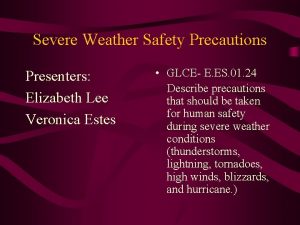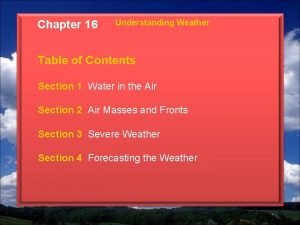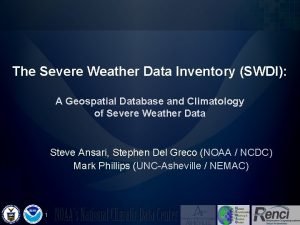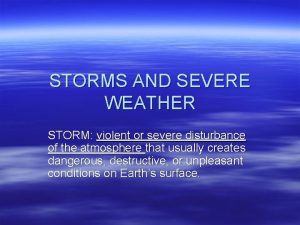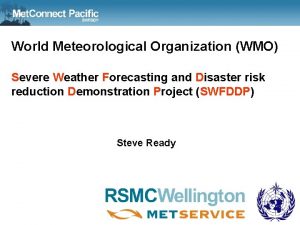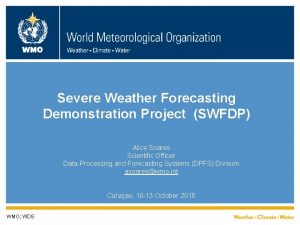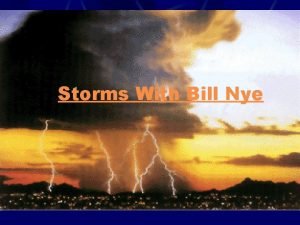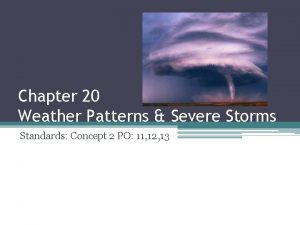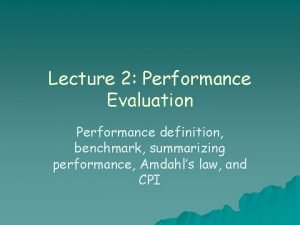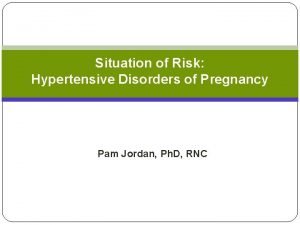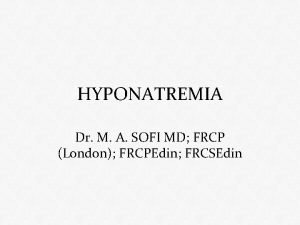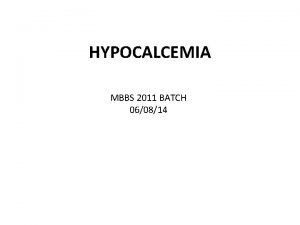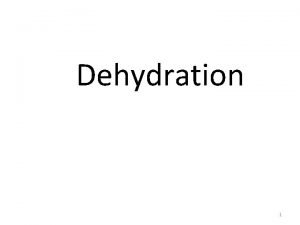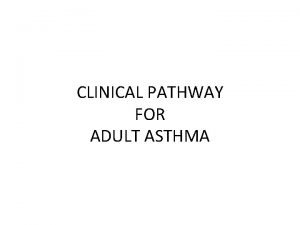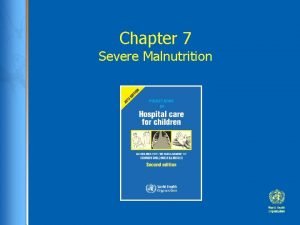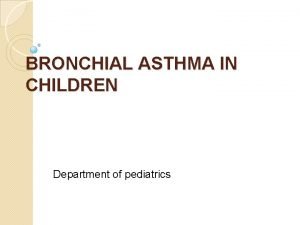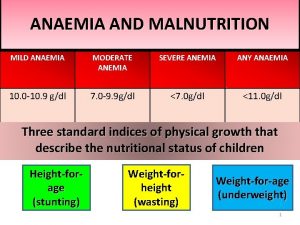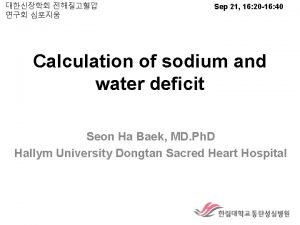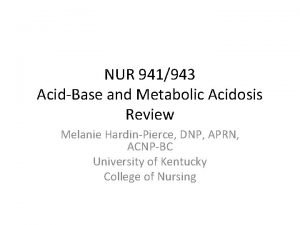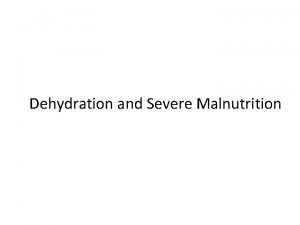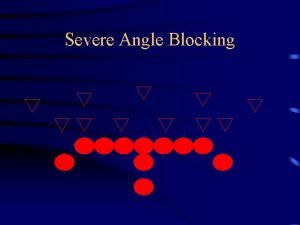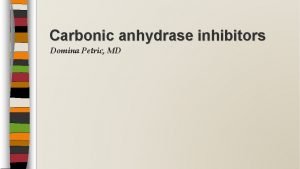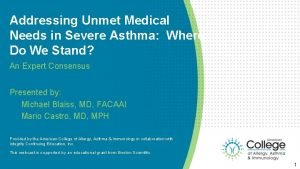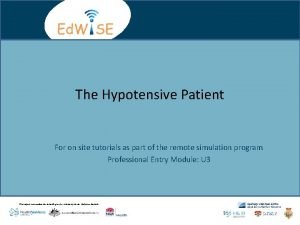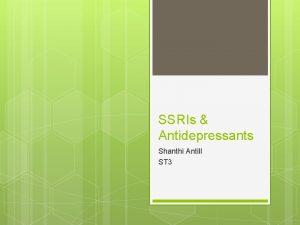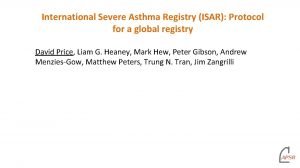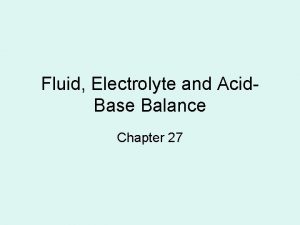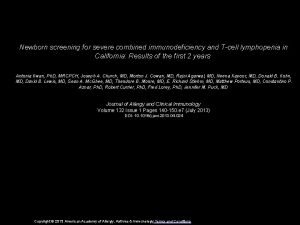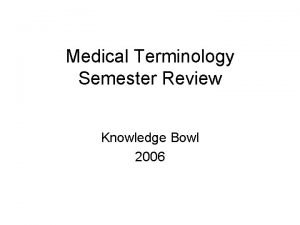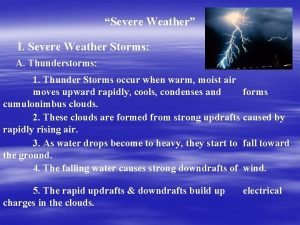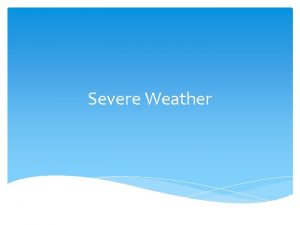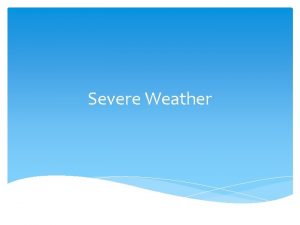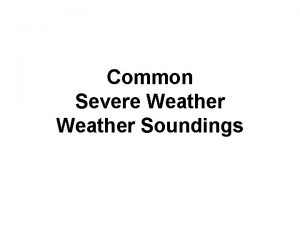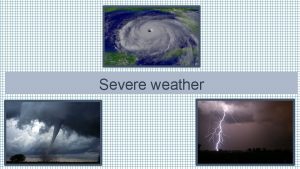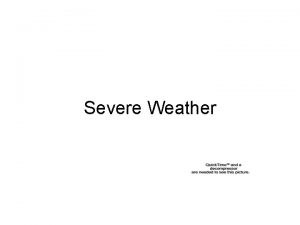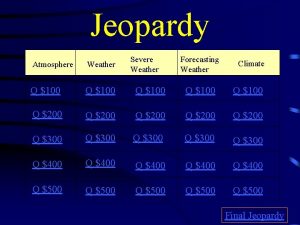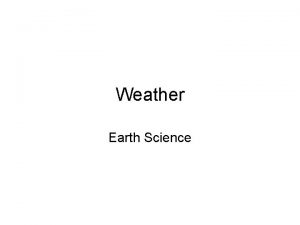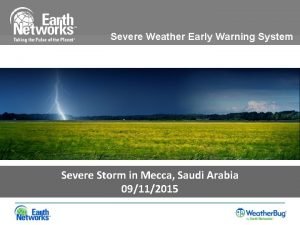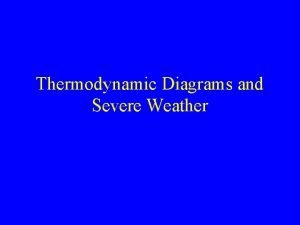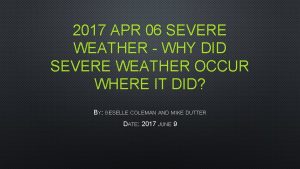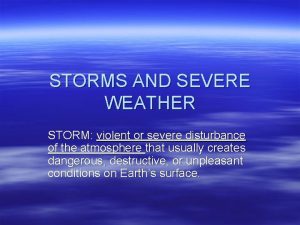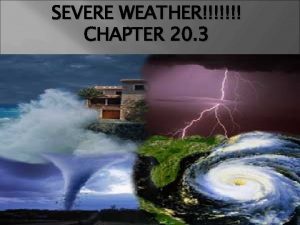SEVERE WEATHER Lecture 9 Definition of a Severe






























































- Slides: 62

SEVERE WEATHER Lecture 9

Definition of a Severe Thunderstorm • The National Weather Service defines a severe thunderstorm as a thunderstorm that produces – Hail of 1 inch diameter or larger And/or – Wind gusts 58 mph or greater – A tornado • Note: this does not include lightning or heavy rain!

When do thunderstorms occur? • During the spring and summer, certain atmospheric conditions can be set up which drive severe convective storms: • Conditionally unstable atmosphere • Moisture • Upward vertical motion (“Lifting”) • Wind shear

Conditional Instability • Recall from a last week…the atmosphere is conditionally unstable if the environmental lapse rate is less than the dry adiabatic lapse rate and greater than the moist adiabatic lapse rate • A “dry” (unsaturated) air parcel will cool at the DALR when lifted. It will always be colder than its environment, and sink back to its original level – STABLE • A “moist” (saturated) air parcel will cool at the MALR when lifted. It will always be warmer than its environment, and continue to rise - UNSTABLE

Moisture • Since a conditionally unstable atmosphere is only unstable with respect to an saturated air parcel, some moisture source is required to create severe weather Cyclones can advect warm, moist air from the Gulf of Mexico into the central plains Other sources of moisture include the Pacific and Atlantic oceans http: //www. srh. noaa. gov/jetstream//tstorms/images/moisture. jpg

Warm, moist air is being advected from the Gulf into the Plains

Vertical Lifting • An unstable atmosphere will only generate severe weather when it is given a “push” • Unstable air parcels can be lifted by the following mechanisms: – Convection – Convergence – Frontal forcing – Topography

Wind Shear • Wind shear is a term which describes how the speed and direction of the wind change with height • It is critically important for the formation of severe weather, because wind shear will keep upward motion and downward motion in the storm separated, allowing the storm to survive

Directional Wind Shear • Wind changes direction with height • Wind is backing if the wind direction rotates counterclockwise with height • Wind is veering if the wind direction rotates clockwise with height • Generally, severe weather will only be found if the wind is veering with height

Directional Shear

Speed shear often causes severe weather with strong straight-line winds

Life Cycle of a Thunderstorm • Building block for any thunderstorm is a thunderstorm cell • Typical thunderstorm lasts approx. 30 minutes • Three stages – Developing stage – Mature Cumulus stage – Dissipating Stage

Developing Stage • Warm, humid air rises and develops an updraft • Air parcels saturate and form a towering cumulus cloud • Little or no rainfall • Lasts near 10 minutes • No severe weather yet

Mature Stage • Precipitation begins to fall, creating downward motion (downdraft) • When downdraft hits the ground, it spreads out and creates a “gust front” • Storm develops overshooting (“anvil”) top • Lasts an average of 1020 minutes. • Most likely time for severe weather (large hail, gusty winds, tornadoes)

• The change in the wind with height forces the downdraft to be separate from the updraft, which allows the storm to live longer and become severe

Mature Thunderstorm • http: //www. geography. hunter. cuny. edu/~tbw/wc. notes/10. thunderstorms. tornadoes/thunder storm. jpg

Roll cloud in Dodge County -not attached to parent thunderstorm cloud -associated with thunderstorm gust front. Sign of possible microburst activity

Shelf Cloud - Associated with a thunderstorm gust front - Attached to parent thunderstorm cloud - Rising cloud motion often can be seen in the leading (outer) part of the shelf cloud, while the underside often appears turbulent, boiling, and wind-torn.

Dissipating Stage • Downdraft dominates and shuts off the updraft • Gust front moves out ahead of the storm and cuts off inflow of warm, moist air • Severe weather threat diminished • Lightning still a threat • Other storms may develop along outflow boundary

Gust Front / Outflow Boundary on Radar

Types of Thunderstorms • • Ordinary Cell Multi-cell Cluster Multi-cell Line (aka Squall line) Supercell thunderstorm

Tornadoes • A tornado is defined as “a violently rotating column of air descending from a thunderstorm and IN CONTACT with the ground. ” -NWS • Can sometimes last for more than an hour and travel several miles • Most violent tornadoes are capable of tremendous destruction with wind speeds of 250 mph or more

What causes tornadoes? • Tornadoes in the winter and early spring are often associated with strong frontal systems that form in the Central US and move east • During the spring in the Central Plains, thunderstorms develop along a dryline – separates very warm, moist area to the east from hot, dry air to the west. • Tornadoes may form as thunderstorms fire along the dryline during the afternoon hours

How Do Tornadoes Form? • Before thunderstorms develop, a change in wind shear creates an invisible, horizontal spinning effect near the surface.

How Do Tornadoes Form? • Rising air within the thunderstorm updraft tilts the rotating air from horizontal to vertical http: //www. nssl. noaa. gov/edu/safety/tornadoguide. html

How Do Tornadoes Form? • An area of rotation, 2 -6 miles wide, now extends through much of the storm. • Most strong and violent tornadoes form within this area of strong rotation http: //www. nssl. noaa. gov/edu/safety/tornadoguide. html

Tornado Facts • Some tornadoes may form during the early stages of rapidly developing thunderstorms. – Most common along range of Rocky Mountains, the Plains, and the western US • Tornadoes may appear nearly transparent until dust and debris are picked up • Two or more tornadoes may occur at the same time from the same storm.

Tornado Facts • The average tornado moves SW to NE but tornadoes have been known to move in every direction. • The average forward speed of a tornado is 30 mph • Tornadoes can accompany tropical storms and hurricanes as they move over land • Tornadoes are most likely to occur between 3 pm and 9 pm



Tornado on Radar

Wedge Tornado http: //greek. wunderground. com/data/wximagenew/m/Mike. Theiss/453. jpg

Rope Tornado http: //www. outdoor. com/wp-content/uploads/2008/01/ropetornado. jpg

Tornadoes in Wisconsin Stoughton, 8/2005 Tornado - Storm Chaser Scott A. Kampas

Cool Tornado Video • http: //www. weather. com/multimedia/video player. html? clip=14517&from=tv_program _vortex

Tropical Cyclones • A tropical cyclone is a low pressure system that develops over tropical or subtropical waters (between 30º N and 30º S) • Develop in areas without a horizontal temperature gradient • Does not have fronts • Has a warm core center • Has an organized circulation

Hurricane Katrina- 2005

Tropical Cyclone Names • Depending upon location, tropical cyclones have different names around the world • In the – Atlantic/Eastern Pacific Oceans: hurricane – Western Pacific: typhoon – Indian Ocean: tropical cyclone

Hurricane Typhoon Cyclone • Do not typically form within 5° latitude of the equator due to the lack of sufficient Coriolis Force

Tropical Cyclone Names • Since 1953, Atlantic tropical storms have been named from lists made by the National Hurricane Center (NHC) • In 1979, men’s names were introduced and they alternate with the women’s names • Six lists are used in rotation

Tropical Cyclone Names • The only time that there is a change in the list is if a storm is so deadly or costly that future use of its name would be inappropriate – Essentially the storm name is “retired” – For example, Andrew 1992, Katrina 2005, Gustav and Ike 2008 • In the event that more than 21 tropical cyclones occur in a season, additional storms will take names from the Greek alphabet – Alpha, Beta, Gamma, Delta, etc

How Do Tropical Cyclones Develop? • Several favorable environmental conditions must be in place before a tropical cyclone can form: – Some initial disturbance such as a thunderstorm complex, which may slowly develop – Warm ocean waters (at least 80°F) – Potentially unstable atmosphere favorable to convection – Moist air near the middle of the troposphere – Low values of vertical wind shear between the surface and upper troposphere • If these conditions persist for several days, a tropical cyclone may form

How Do Tropical Cyclones Strengthen? • Tropical cyclones strengthen and maintain themselves through latent heat release • As water vapor rises, it cools and condenses • Large quantities of latent heat release warm the air, causing it to be less dense than its surroundings • The ideal gas law tells us that the pressure should then decrease • The storm must be over warm ocean waters to supply enough moisture

Stages of Hurricane Development • When these disturbances first appear, they are called tropical depressions – Not named yet • Once the disturbance has developed with surface wind speeds stronger than 39 mph, the storm is classified as a tropical storm • After further strengthening and surface wind speeds greater than 74 mph, the system is upgraded to a hurricane • Atlantic Hurricane season is June 1 – November 30



Air converges in the center in a cyclonic pattern and diverges at the top. In the center of the storm, called the “eye”, the storm is mostly cloud-free http: //www. srh. noaa. gov/jetstream//tropics/tc_structure. htm


Tropical Cyclone Structure • The main parts of a tropical cyclone are the eye, the eyewall, and the rainbands • The eye – Strong rotation of the cyclone causes a vacuum of sinking air at the center which suppresses cloud formation – This creates a pocket of generally clear, calm conditions in the center – Typically 20 -40 miles across – Will usually develop when the winds exceed 74 mph but cause of eye formation still not fully understood

Tropical Cyclone Structure • The eyewall – Consists of a ring of thunderstorms that produce heavy rains – Usually produces the strongest winds of the storm – Changes in the structure of the eyewall and eye can cause changes in wind speed – Double eyewalls can form if the eye changes size


Tropical Cyclone Structure • The rainbands – Curved bands of clouds and thunderstorms that trail away from the eyewall in a sprial fashion – Capable of producing heavy bursts of rain and wind, as well as tornadoes – Sometimes gaps in the spiral bands where no rain or wind is found – if one were to travel between the outer edge of a hurricane to its center, one would progress from light rain and wind, to dry and weak breeze, then back to increasingly heavier rainfall and stronger wind, over and over again

RAINBAND EYEWALL EYE HURRICANE KATRINA

What is storm surge? • As the surface winds converge toward the center of the storm, they “pile up” ocean water • Also, the decreased surface pressure raises the sea level slightly • Strong waves also can increase the water height

What causes the most damage? • A hurricane can cause damage by many different aspects – Very strong winds can damage structures – Heavy rainfall can cause flooding – Storm surge can inundate low-lying areas – Occasionally, lightning strikes and/or tornadoes can cause damage • Storm surge generally causes the most damage and deaths, particularly in strong hurricanes

Damage from Hurricane Ivan

2005 Atlantic Hurricane Season • Was the most active Atlantic hurricane season in recorded history • Forecasts fell far short of the actual activity • Most tropical storms, hurricanes, and Category 5 hurricanes recorded in one season • 27 named tropical storms, 17 became hurricanes • 7 major hurricanes • 4 Category 5 hurricanes – Emily, Katrina, Rita, Wilma • Widespread economical effects

Hurricane Katrina - 2005 • Katrina was the 6 th strongest hurricane on record for the Atlantic Ocean • After entering the Gulf, rapidly intensified from Cat. 3 to Cat. 5 in 9 hours on August 28 • Lowest pressure as Cat. 5 storm was 902 mb with max sustained winds of 175 mph • Weakened slightly before landfall to a Category 3 • Hurricane force winds extended 120 miles from the center

Katrina’s Path Made landfall August 29, 2005 as Cat. 3

Katrina eye viewed from NOAA Hurricane Hunters August 28, 2005

Katrina’s Impact • Largest natural disaster in the history of the U. S. • Attributed to over 1830 deaths and 700 missing people, mostly in Louisiana and Mississippi • Damages well in excess of $100 billion • Federal disaster declarations covered 90, 000 sq miles (size of United Kingdom) • 8 -16 inches of rain • Breaching of levees caused 80% of New Orleans to be flooded

Time Lapse of Hurricane Katrina • http: //www. youtube. com/watch? v=_SLXY RJn. Ym 0&feature=related • http: //www. youtube. com/watch? v=w. FQy. X 73 ee. OA&NR=1
 Chapter 20 weather patterns and severe storms
Chapter 20 weather patterns and severe storms Severe weather safety precautions worksheet
Severe weather safety precautions worksheet Chapter 16 section 1 water in the air answer key
Chapter 16 section 1 water in the air answer key Severe weather data inventory
Severe weather data inventory Severe weather graphic organizer
Severe weather graphic organizer Wmo severe weather
Wmo severe weather Swfdp
Swfdp Bill nye storms
Bill nye storms Chapter 20 weather patterns and severe storms
Chapter 20 weather patterns and severe storms 01:640:244 lecture notes - lecture 15: plat, idah, farad
01:640:244 lecture notes - lecture 15: plat, idah, farad Weather map station model light rain
Weather map station model light rain Tongue twister winter
Tongue twister winter Poem on seasons
Poem on seasons Sunny rainy cloudy stormy
Sunny rainy cloudy stormy Whether the weather is fine
Whether the weather is fine Heavy weather by weather report
Heavy weather by weather report Capital weather gang weather wall
Capital weather gang weather wall Causes of cotton wool spots
Causes of cotton wool spots Lecture chorale définition
Lecture chorale définition Lecture expressive definition
Lecture expressive definition Définition de la lecture méthodique
Définition de la lecture méthodique Definition of lecture method
Definition of lecture method Lecture performance definition
Lecture performance definition 2015 whmis quiz answers
2015 whmis quiz answers Magnesium sulfate toxicity level
Magnesium sulfate toxicity level Katrine zhiroff
Katrine zhiroff Severe hyponatremia treatment
Severe hyponatremia treatment Severe hypocalcemia
Severe hypocalcemia Trousseau sign
Trousseau sign Mild moderate severe dehydration
Mild moderate severe dehydration Types of dehydration
Types of dehydration Asthma clinical pathway
Asthma clinical pathway Malnutrition case presentation
Malnutrition case presentation Etiology of bronchial asthma
Etiology of bronchial asthma Mild moderate severe asthma exacerbation
Mild moderate severe asthma exacerbation Severe anemia
Severe anemia What is life
What is life S2 os gap
S2 os gap Fluid of choice in severe dehydration
Fluid of choice in severe dehydration Site:slidetodoc.com
Site:slidetodoc.com Anemia tibc ferritin iron
Anemia tibc ferritin iron Dka criteria
Dka criteria Resomal composition
Resomal composition A 23 year old male experienced severe head trauma
A 23 year old male experienced severe head trauma Severe angle
Severe angle Severe pong game cards
Severe pong game cards Domina severe
Domina severe Rexocef 100 mg
Rexocef 100 mg Unmet needs in severe asthma
Unmet needs in severe asthma Vce stress
Vce stress Outsiders chapter 7 vocabulary
Outsiders chapter 7 vocabulary Severe dehydration
Severe dehydration Anxiety headache
Anxiety headache How to make a pong game in scratch
How to make a pong game in scratch International severe asthma registry
International severe asthma registry Potassium dose calculation
Potassium dose calculation Severe dehydration
Severe dehydration Severe dehydration
Severe dehydration Severe obesity
Severe obesity Hyponatremia correction
Hyponatremia correction Best laxative for impacted stool
Best laxative for impacted stool Combined immunodeficiency
Combined immunodeficiency Bowl in medical term
Bowl in medical term

